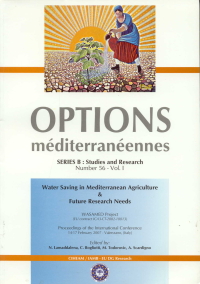| Article précédent | p. 153-168 | Article suivant |
Deficit irrigation of sunflower under Mediterranean environmental conditions
This work aims at: analyzing response of sunflower crop to several irrigation water regimes and evaluating the suitability of sunflower to deficit irrigation strategies. An open-field trial on hybrid Sanbro_MR was carried out at experimental fields in Valenzano (Bari, Southern Italy), characterized by semi-arid Mediterranean climate and clay-loamy soil. The experiment includes five irrigation regimes: optimal water supply, application of 100 percent of water requirements up to flowering and 70 percent thereafter, application of 70 percent of water requirements through the whole season, application of 70 percent of water requirements up to flowering and rainfed conditions thereafter, and rainfed conditions during the whole season. Sunflower response to water supply and intensity, timing and duration of water stress was investigated by means of leaf area index (LAI), radiation interception, biomass production, water consumption, yield, water use efficiency (WUE) and radiation use efficiency (RUE). The overall results indicate deficit irrigation as an acceptable strategy for sunflower highlighting the importance of irrigation between flowering and maturity.
Ce travail vise à analyser la réponse de la culture de tournesol à plusieurs régimes hydriques et à évaluer l'aptitude de la plante aux stratégies d'irrigation déficitaire. Une expérimentation a été menée sur l'hybride Sanbro_MR cultivé dans les champs expérimentaux de Valenzano (Bari, Italie du Sud), dans un climat méditerranéen semi-aride et sur un sol moyennement argileux. L'expérience comprend cinq régimes d'irrigation: un apport hydrique optimal, une application à 100 pour cent des besoins en eau jusqu'à la floraison puis à 70 pour cent, une application de 70 pour cent des besoins en eau durant toute la saison, une application de 70 pour cent des besoins en eau jusqu'à la floraison suivie d'un régime en culture pluviale et enfin, un régime de culture pluviale pendant toute la saison. La réponse du tournesol à l'intensité de l'apport hydrique et à la durée de sa contrainte a été étudiée à l'aide des moyens suivants : l'indice de surface foliaire (LAI), l'interception du rayonnement, la production de biomasse, la consommation en eau, le rendement, l'efficience d'utilisation de l'eau (WUE) et l'efficience d'utilisation du rayonnement (RUE). Les résultats globaux indiquent que l'irrigation déficitaire est une stratégie acceptable pour le tournesol et soulignent l'importance de l'irrigation entre la floraison et la maturité.
- [ Afficher ]
- [ Télécharger ]
- [ Exporter la citation ]
Vous pouvez télécharger la citation au format :
- [ Imprimer ]
-
Mots-clés
DOSE D'IRRIGATION, EFFICACITE, HELIANTHUS ANNUUS, ITALIE, METHODE D'IRRIGATION, REPONSE DE LA PLANTE, UTILISATION DE L'EAUCiter cet article
Todorovic M., Albrizio R., Zivotic L. Deficit irrigation of sunflower under Mediterranean environmental conditions. In : Lamaddalena N. (ed.), Bogliotti C. (ed.), Todorovic M. (ed.), Scardigno A. (ed.). Water saving in Mediterranean agriculture and future research needs [Vol. 1]. Bari : CIHEAM, 2007. p. 153-168. (Options Méditerranéennes : Série B. Etudes et Recherches; n. 56 Vol.I). Proceedings of the International Conference WASAMED Project (EU contract ICA3-CT-2002-10013), 2007/02/14-17, Valenzano (Italy). http://om.ciheam.org/om/pdf/b56_1/00800109.pdf



